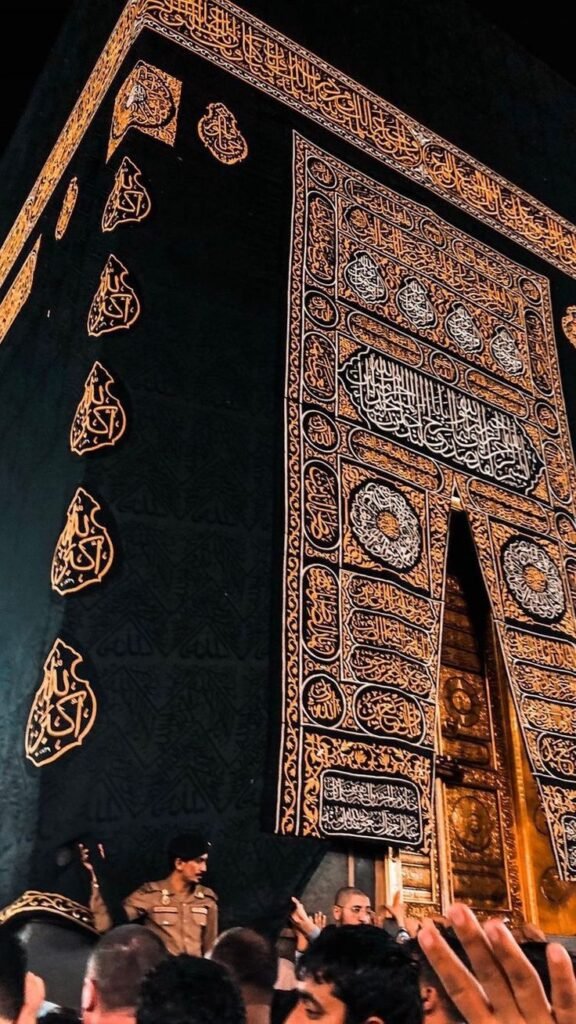In the heart of the Muslim world, the holy Kaabah represents togetherness, faith and spiritual growth. Millions pray toward the Kaabah and many Muslims also include attending it in their Hajj and Umrah journey. Another remarkable thing about the Kaabah is the Ghilaf-e-Kaabah, the beautiful black and gold covering that covers it. The cloth is greatly respected, loved and has a long history and significant meaning in Islam. This article looks into how the Kaabah’s cloth is significant and describes its background, craft and cultural changes. Hajar Travels believes that exploring the history of religious artifacts can help someone become closer to their faith during their Hajj and Umrah.
What is the Ghilaf-e-Kaabah
The Ghilaf-e-Kaabah is the black silk cover that completely surrounds the building in Makkah. There is no comparison to its aesthetic as it is covered with embroidery that cites verses from the Quran. As well as adding to the physical beauty of the Kaabah, Ghilaf is also highly sacred. The cloth helps to honor the sanctity of the Kaabah by showing how Muslims respect and surrender to Allah. The lovely appearance results from Muslims’ strong respect for the shrine.
The History and Evolution of the Cloth of Kaabah
Covers for the Kaabah have been used as long as the Kaabah has existed. It is believed from ancient sources that, when Prophet Ibrahim (AS) lived, the Kaabah was left uncovered. It was King Tubb'a Abu Karab As'ad of Yemen, in the 5th century, who began a tradition by placing the first known cloth over the Kaabah. As the Prophet Muhammad (PBUH) lived, the tradition of changing the cloth every year became well known. Wrapped in a Yemeni cloth, the Prophet (PBUH) covered the Kaabah and the replacement changed the course of history. Umayyads and Abbasids later followed this practice and each made changes to the buildings they constructed. Now, creating the Ghilaf is done at a level of sophistication never before reached. Since 1927, the Kingdom of Saudi Arabia has used the Kiswa Factory which employs many artisans, to make the cloth.
Craftsmanship of the Ghilaf-e-Kaabah
It requires a lot of effort, creativity and art to make the cloth called Kaabah. Black silk forms the Ghilaf and 120 kilograms of genuine gold and silver are used to decorate the Islamic handwriting on it. At the start, special silk threads are handpicked and dyed to get the striking black color. After that, skilled artists embroider the golden Quranic verses by hand over a long period of care. A total of five pieces is in the Ghilaf, with four covering the walls of the Kaabah and the fifth serving as the curtain over the door. A new magnificent cloth is put in place every year during the Hajj, to illustrate the clothing’s spiritual meaning. The Kiswa from before is sliced into small portions and given to dignitaries, places of worship and individuals as a respected symbol.
Symbolism Behind the Ghilaf-e-Kaabah
The cloth of Kaabah is more than just a beautiful covering; it is rich with symbolic meanings that resonate deeply with the Muslim Ummah.
- Black and Gold Colors: The black represents the simplicity and humility that every Muslim should embody, while the gold signifies the majesty and glory of Allah.
- Quranic Embroidery: The verses embroidered on the Ghilaf remind worshippers of Allah's words and serve as a visible connection to the Quran.
- Unity: The Kaabah, along with its sacred covering, unites Muslims in prayer, regardless of race, nationality, or social status.
- Reminder of Devotion: The Ghilaf serves as a constant reminder of the devotion, precision, and care we must maintain toward our faith.
Significance for Pilgrims
For many people doing Hajj or Umrah in Makkah, the beautifully covered Kaabah brings about awe, reverence and emotional attachment. The words written on the cloth inspire people to focus on what the Quran teaches and seeing how special the cloth is lets them feel the presence of God’s mercy. Many times, we explain at Hajar Travels that the Ghilaf is as much spiritual as it is physical, helping those on pilgrimage feel more connected to Allah. It increases the depth of the Tawaf and everything you experience in front of the Kaabah.
Preserving This Timeless Tradition
While the Saudi government has taken significant steps to preserve and continuously innovate the Ghilaf-e-Kaaba production, public awareness and reverence for its significance are equally crucial. With advancements in technology and artistry, this centuries-old tradition continues to symbolize the eternal values of Islam, standing as a tribute to the faith and unity of the Muslim Ummah.
Planning Your Umrah Pilgrimage in 2025
Have you booked your Umrah trip to occur soon? Watching the recordings anytime gives you a chance to appreciate and gain knowledge from the Kaabah cloth. Hajar Travels tries to ensure its clients enjoy an easy and fulfilling Umrah 2025 Journey. There are many travelers who have learned about the Kaabah’s history and wonderful nature due to us. Hajar Travels ensures that you get support with rituals, good accommodation and smooth transfers from one spot to the next.
Find Deeper Meaning in Every Ritual
The covering of the Kaaba represents a lot of work, creativity and commitment to faith spanning many years. Viewing the Ghilaf brings to mind for every pilgrim the need to serve Allah with humility and love. If you start your journey from Makkah, Hajar Travels has the services and staff available to help you. When you are planning your trip to Hajj or Umrah, let us know and you can admire the festive and special look of the Kaaba cloth.



